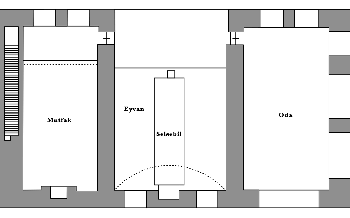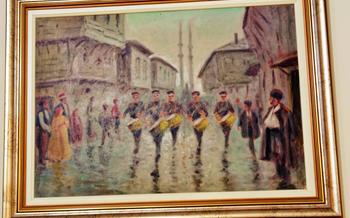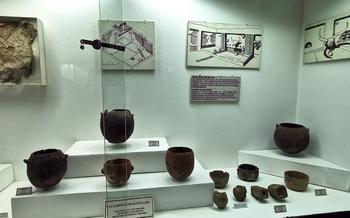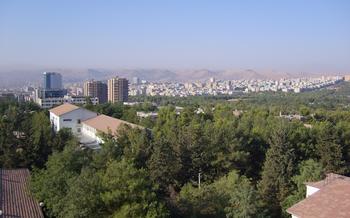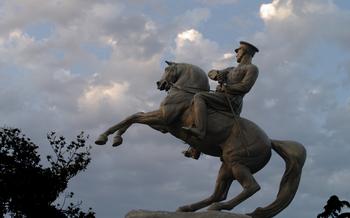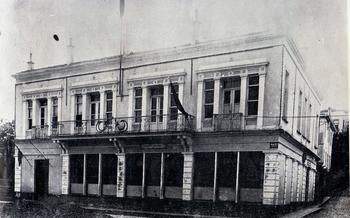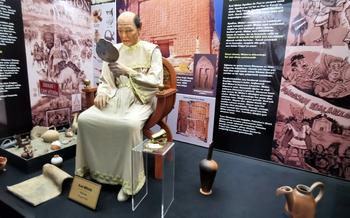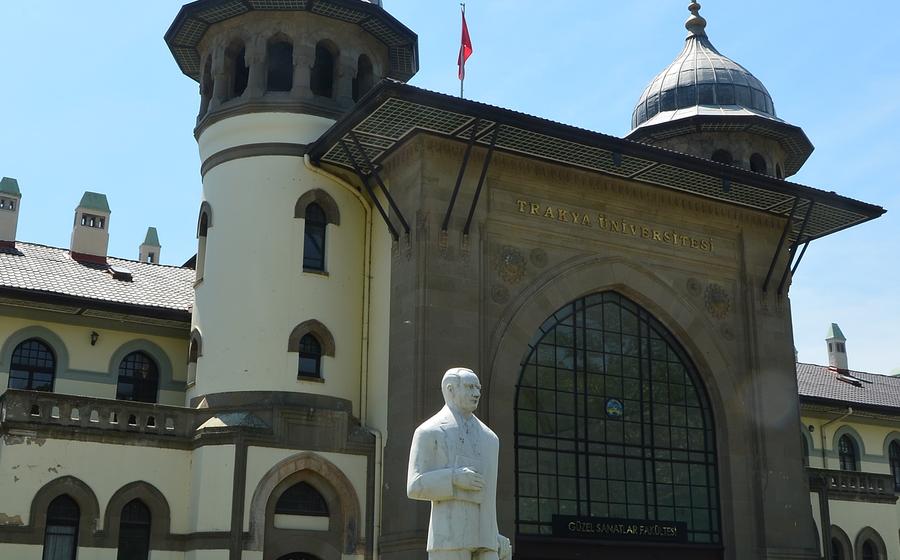
Karaağaç Statue of Atatürk
- The Majestic Symbol: Unveiling the Karaağaç Statue of Atatürk
- Location and Accessibility: Finding Your Way to the Karaağaç Monument
- Historical Context: Understanding Atatürk's Legacy in Edirne
- Atatürk's Legacy in Edirne
- Art and Architecture: Admiring the Statue's Design and Craftsmanship
- Meaning and Significance: Exploring the Statue's Symbolism
- Atatürk's Visit to Edirne: The Story Behind the Statue
- Visiting Tips: Making the Most of Your Experience
- Photography Opportunities: Capturing the Statue's Grandeur
- Historical Significance: The Statue in the Context of Turkish History
- Cultural Impact: The Statue's Influence on Turkish Society
- Maintenance and Preservation: Ensuring the Statue's Legacy
- Local Traditions and Customs: Respecting Turkish Culture
- Educational Value: The Statue as a Teaching Tool
The Majestic Symbol: Unveiling the Karaağaç Statue of Atatürk
Amidst the vibrant city of Edirne, a majestic symbol of Turkish history stands tall - the Karaağaç Statue of Atatürk. Unveiled in 1930, this iconic monument pays homage to the revered founder of the Turkish Republic, Mustafa Kemal Atatürk. The statue not only represents Atatürk's extraordinary leadership and vision but also serves as a poignant reminder of Turkey's struggle for independence.
Standing proudly in the heart of Edirne, the Karaağaç Statue of Atatürk embodies the spirit of a nation that rose from the ashes of war. Its historical significance is deeply intertwined with Atatürk's pivotal role in the Turkish War of Independence, a conflict that shaped the destiny of the Turkish people.
The statue, crafted with intricate detail and artistic finesse, captures the essence of Atatürk's resolute personality. Its design features a commanding figure of Atatürk, dressed in military attire, atop a granite pedestal. The statue's powerful stance and unwavering gaze symbolize his determination and leadership during Turkey's darkest hours.
Beyond its historical significance, the Karaağaç Statue of Atatürk stands as a symbol of national unity and pride. It serves as a constant reminder of the sacrifices made by countless individuals who fought for Turkey's freedom and sovereignty. The statue's presence in Edirne, a city with a rich historical and cultural heritage, further enhances its symbolic importance, making it a must-visit destination for anyone seeking to understand the true essence of Turkey's journey towards independence and progress.
Location and Accessibility: Finding Your Way to the Karaağaç Monument
The Karaağaç Statue of Atatürk is prominently situated in Edirne's central district, at the heart of the city's cultural and historical hub. To reach this iconic landmark, visitors can navigate to the exact address: Cumhuriyet Meydanı, Karaağaç, Edirne. Whether exploring the city on foot or arriving by vehicle, the statue's central location makes it easily accessible.
For those opting for public transportation, Edirne offers convenient options. The city's efficient bus network provides routes that stop near the statue, allowing visitors to alight just steps away from this majestic tribute to Atatürk. Alternatively, taxis are readily available, offering a comfortable and direct mode of transport to the monument.
If arriving by car, visitors will find ample parking options in the vicinity. Designated parking areas are located within walking distance of the statue, ensuring a hassle-free visit. The statue's central location also places it in close proximity to other notable landmarks and attractions, making it an ideal starting point for exploring the city's rich cultural heritage.
Historical Context: Understanding Atatürk's Legacy in Edirne
The Karaağaç Statue of Atatürk stands as a testament to the profound impact of Mustafa Kemal Atatürk, the founder of the Republic of Turkey, on the city of Edirne and the nation as a whole. Atatürk played a pivotal role in the Turkish War of Independence, leading the Turkish forces to victory against the Allied powers and securing the establishment of an independent Turkish state.
Edirne, located in northwestern Turkey near the border with Greece and Bulgaria, holds a special place in Turkish history. Throughout the centuries, the city has been a strategic military and cultural center, and its capture by the Ottoman Empire in 1361 marked a significant moment in the empire's expansion.
Atatürk's Legacy in Edirne
Atatürk's visit to Edirne in 1922, shortly after the Turkish War of Independence, was a historic event that cemented his legacy in the city. During his visit, he delivered a powerful speech in which he emphasized the importance of national unity and progress, leaving a lasting impression on the people of Edirne.
The Karaağaç Statue of Atatürk serves as a poignant reminder of Atatürk's significant contributions to Turkey's independence and his enduring legacy in Edirne. It is a symbol of the determination and resilience of the Turkish people and a testament to the profound impact of Atatürk's leadership and vision.
Art and Architecture: Admiring the Statue's Design and Craftsmanship
The Karaağaç Statue of Atatürk stands as a testament to the fusion of art and architecture, embodying the spirit of modern Turkey. Crafted with meticulous attention to detail, the statue showcases the artistic prowess of its creators, capturing the essence of Atatürk's legacy through its design and construction.
The statue's artistic style blends elements of realism and symbolism, portraying Atatürk with lifelike accuracy while imbuing his figure with symbolic significance. The sculptor, Mehmet Aksoy, masterfully captured Atatürk's characteristic features, from his determined gaze to his commanding stance, ensuring that the statue exudes a sense of authority and leadership.
Constructed using bronze, a durable and resilient material, the statue has withstood the test of time, maintaining its grandeur despite the passage of years. The intricate details of Atatürk's uniform, the folds of his cloak, and the texture of his hair are meticulously rendered, testament to the sculptor's skill and craftsmanship.
The statue's pedestal is adorned with reliefs depicting scenes from Atatürk's life and accomplishments, further enhancing the narrative of his legacy. These reliefs add depth and context to the statue, providing a visual representation of Atatürk's pivotal role in shaping Turkey's destiny.
Overall, the Karaağaç Statue of Atatürk is a masterpiece of art and architecture, combining realism, symbolism, and craftsmanship to create a lasting tribute to the father of modern Turkey.
Meaning and Significance: Exploring the Statue's Symbolism
The Karaağaç Statue of Atatürk stands as a powerful symbol of Mustafa Kemal Atatürk's legacy and the Turkish nation's unwavering commitment to independence and unity. It embodies the ideals and principles that Atatürk championed throughout his life, serving as a constant reminder of his transformative role in shaping modern Turkey.
The statue's commanding presence evokes Atatürk's strong leadership and visionary spirit. His determined gaze and outstretched hand symbolize his unwavering dedication to guiding Turkey towards progress and modernization. The statue captures his indomitable spirit and unwavering belief in the potential of the Turkish people.
The Karaağaç Statue also serves as a poignant commemoration of Turkey's struggle for independence. It pays tribute to the countless sacrifices made by the Turkish people during the Turkish War of Independence, honoring their bravery and resilience in the face of adversity. The statue stands as a testament to their unwavering determination to achieve freedom and self-determination.
Furthermore, the statue embodies the spirit of national unity and pride. It represents Atatürk's vision of a unified and prosperous Turkey, free from the shackles of foreign influence and internal strife. The statue's prominent position in Edirne, a city steeped in historical significance, underscores its role in fostering a sense of national identity and belonging among all Turkish citizens.
Atatürk's Visit to Edirne: The Story Behind the Statue
Mustafa Kemal Atatürk, the founder and first president of the Republic of Turkey, visited Edirne on November 15, 1930, during a tour of the country's provinces. His visit to Edirne held great significance as it was his first visit to the city after the Turkish War of Independence and the establishment of the republic. Atatürk's visit was met with great enthusiasm and excitement by the people of Edirne, who lined the streets to welcome him.
During his visit, Atatürk inspected various institutions, including schools, hospitals, and military facilities, and met with local officials and representatives. He also took the opportunity to address the citizens of Edirne, emphasizing the importance of unity, progress, and education in building a strong and prosperous nation.
Atatürk's visit to Edirne was a historic event that left a lasting impact on the city. Not only did it demonstrate his commitment to the development of all regions of Turkey, but it also inspired the people of Edirne to strive for progress and modernization. The statue of Atatürk in Karaağaç stands as a testament to his legacy and the enduring spirit of the Turkish people.
Visiting Tips: Making the Most of Your Experience
To fully appreciate the grandeur of the Karaağaç Statue of Atatürk, plan your visit during the early morning or late afternoon when the sun's golden rays illuminate the statue, creating a breathtaking spectacle. Allow at least 30 minutes to immerse yourself in the statue's intricate details, its symbolism, and the surrounding scenery. Choose a viewing angle that captures the statue's full height and majesty, allowing you to admire its impressive scale. Be mindful of weather conditions as Edirne experiences both hot summers and cold winters. Dress accordingly and consider visiting during the shoulder seasons of spring or autumn for a more comfortable experience. Accessibility is generally good, but it's advisable to plan your transportation in advance. Whether you prefer the convenience of public transportation or the flexibility of a private vehicle, ensure you have the necessary information to reach the statue seamlessly.
Photography Opportunities: Capturing the Statue's Grandeur
The Karaağaç Statue of Atatürk presents an exceptional opportunity for photography enthusiasts to capture the grandeur of this iconic monument. With its imposing size and intricate details, the statue offers a variety of angles and perspectives for photographers to showcase its majesty.
To capture the statue's full splendor, position yourself directly in front of it, allowing its towering height to dominate the frame. This angle provides a classic perspective that emphasizes the statue's commanding presence. Alternatively, step to the side and shoot from a diagonal angle to create a more dynamic composition. This angle allows you to incorporate the surrounding environment, such as the park's lush greenery or the city skyline, into your shot.
For a unique perspective, consider photographing the statue from below. This angle accentuates the statue's colossal size and creates a sense of awe and wonder. Experiment with different focal lengths to achieve your desired effect. A wide-angle lens can capture the statue in its entirety, while a telephoto lens can zoom in on specific details, such as Atatürk's determined gaze or the intricate carvings on his uniform.
Remember to take advantage of the natural light to enhance your photographs. Early morning or late afternoon light provides a warm, golden glow that illuminates the statue's features and adds depth to the scene. If you're visiting during the day, use a polarizing filter to reduce glare and enhance the colors of the statue and its surroundings.
As you photograph the statue, pay attention to the composition and background elements. Ensure that the statue is the focal point of your image and that the background doesn't distract from its impact. Remove any unwanted objects or people from the frame to create a clean and uncluttered composition.
Finally, when taking photos at the Karaağaç Statue of Atatürk, be respectful of the memorial site and its visitors. Avoid using flash photography, as it can be disruptive to others, and be mindful of your noise level. By following these tips, you can capture stunning photographs of this iconic statue that will serve as lasting memories of your visit to Edirne.
Historical Significance: The Statue in the Context of Turkish History
The Karaağaç Statue of Atatürk holds immense historical significance in the context of Turkey's past and present. Erected in 1927, the statue serves as a tangible reminder of Turkey's struggle for independence and the pivotal role played by Mustafa Kemal Atatürk. The statue symbolizes the culmination of Atatürk's visionary leadership and the successful establishment of the Turkish Republic. It stands as a testament to the sacrifices made by the Turkish people during the Turkish War of Independence and their unwavering determination to forge a new path for their nation. The statue's enduring presence serves as a reminder of the challenges and triumphs that shaped modern Turkey, inspiring future generations to uphold the principles of democracy, unity, and progress.
Cultural Impact: The Statue's Influence on Turkish Society
The Karaağaç Statue of Atatürk holds immense cultural significance, serving as a symbol of unity and progress in Turkish society. It embodies the ideals and values espoused by Atatürk, the founder of modern Turkey, and inspires feelings of national pride and patriotism among Turkish citizens. The statue's presence in Edirne, a city with a rich historical and cultural heritage, further reinforces its importance as a symbol of Turkey's identity.
Atatürk's legacy continues to shape Turkish society, and the statue serves as a reminder of his vision for a modern, secular, and progressive nation. The statue's prominent placement in Edirne reflects the deep respect and admiration that Turkish people have for Atatürk and his contributions to the country's development. It stands as a testament to his enduring influence and the enduring values that he instilled in Turkish society.
Furthermore, the statue has played a crucial role in promoting Atatürk's ideas and principles, which emphasize the importance of education, science, and modernization. Through its symbolic presence, the statue inspires generations of Turks to strive for excellence, embrace innovation, and contribute to the progress of their nation. It serves as a constant reminder of the values that have shaped Turkey's transformation into a modern and vibrant society.
Maintenance and Preservation: Ensuring the Statue's Legacy
The Karaağaç Statue of Atatürk, standing as a symbol of Turkey's independence and Atatürk's legacy, requires meticulous care and preservation to ensure its enduring presence. Over the years, efforts have been made to maintain and restore the statue, ensuring its continued significance for generations to come.
Regular cleaning and maintenance tasks are meticulously carried out to safeguard the statue's structural integrity and aesthetic appeal. These tasks include removing dirt, debris, and environmental pollutants that may accumulate over time. Additionally, experts periodically inspect the statue for any signs of damage or deterioration, ensuring timely repairs or interventions if necessary.
In 2015, the statue underwent a comprehensive restoration project, which involved a thorough cleaning process, structural reinforcement, and the replacement of damaged elements. This project aimed to restore the statue to its original grandeur and address any issues that may have compromised its condition.
The preservation of the Karaağaç Statue of Atatürk is of paramount importance, as it serves as a tangible reminder of Turkey's history and the legacy of its revered leader. By ensuring its longevity, future generations can continue to appreciate and learn from this iconic monument, which stands as a testament to Turkey's struggle for independence and the enduring spirit of its people.
Local Traditions and Customs: Respecting Turkish Culture
When visiting the Karaağaç Statue of Atatürk, it is important to be mindful of Turkish customs and traditions to show respect for the local culture. Dress modestly and avoid wearing revealing or disrespectful clothing. Behave respectfully at the memorial site, maintaining a dignified demeanor. Avoid loud noises, disruptive behavior, or actions that may be seen as disrespectful to Atatürk's legacy. Remember that the statue holds significant cultural and historical importance for the Turkish people, so it is essential to conduct yourself in a manner that demonstrates understanding and appreciation of their customs. By respecting Turkish culture and traditions, you can contribute to a positive and enriching experience for yourself and those around you.
Educational Value: The Statue as a Teaching Tool
The Karaağaç Statue of Atatürk serves as a valuable educational resource, offering a profound glimpse into Turkish history and the life of its revered leader. Schools and educational institutions often incorporate visits to the statue into their curricula, using it as a powerful teaching tool to bring history to life.
Through interactive lessons and discussions, students engage with the statue and its symbolism, learning about Atatürk's instrumental role in shaping Turkey's destiny. They explore the historical context of the Turkish War of Independence and delve into the significance of Edirne, a city that holds a special place in Turkish history and culture.
The statue provides a tangible connection to the past, allowing students to visualize and understand the events that shaped modern Turkey. Its imposing presence encourages contemplation and reflection, inspiring a deeper appreciation for Atatürk's legacy and the enduring values he instilled in Turkish society.
